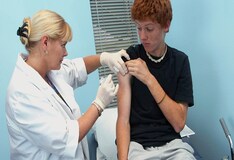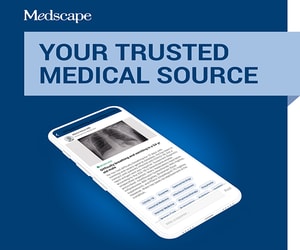Dec. 19, 2005 (Washington) — Two vaccines against human papillomavirus (HPV) target the most oncogenic strains of HPV, according to separate teams of investigators who presented their findings here at the 45th Interscience Conference on Antimicrobial Agents and Chemotherapy.
In a phase 3 study of a quadrivalent HPV vaccine (Gardasil) using a virus-like particle (VLP) against HPV types 6, 11, 16, and 18, investigators found that, in 2 years of follow-up, none of the subjects developed cervical intraepithelial neoplasia (CIN) or more severe lesions, and the vaccine was 95% effective against the development of vulvar and vaginal lesions that can be precursors to CIN.
"Unlike other sexually transmitted diseases, which in combination affect 5% of the population, HPV infects 30% to 80% of the population, including men and women," presenting investigator Diane M. Harper, MD, told Medscape. "This has the possibility of reducing the rate of cervical cancer by 70%. The vaccine is 100% effective against the development of cervical cancer if a woman is not already infected."
Dr. Harper, an associate professor of obstetrics-gynecology and community and family medicine at Norris Cotton Cancer Center, Dartmouth Medical School, in Lebanon, New Hampshire, said that she and other investigators of HPV vaccines believe that it will complement the annual Papanicolaou (Pap) test rather than making it obsolete.
She and her coinvestigators conducted the Females United to Unilaterally Reduce Endo/Ecto-Cervical Cancer (FUTURE) study to see if an HPV vaccine targeting these HPV types would have an effect on diseases that are caused by HPV and are precursors to cervical cancer.
The investigators randomized 5455 women aged 16 to 23 years to receive either the vaccine or the placebo at day 1 and at 2 and 6 months after the initial treatment. The participants underwent Pap tests at regular intervals and colposcopy as is typically recommended with repeat abnormal findings. The investigators analyzed the biopsies for HPV type and arranged for the histology slides to be read by a blinded pathology panel.
The primary end points were CIN grades 1 to 3, the development of adenocarcinoma in situ and cervical cancer; and the development of external genital lesions (EGL), and vulvar or vaginal intraepithelial neoplasia or cancer. The investigators conducted a per-protocol (PP) analysis of patients who received all 3 doses of the vaccine, had no major protocol violations, were seronegative at day 1 and DNA-negative from day 1 to month 7 to the respective HPV type. They also conducted a modified intention-to-treat (MITT) analysis, which included patients who received at least 1 dose and were seronegative, and were seronegative to the respective HPV type at day 1. Follow-up began at month 7 for the PP analysis and on day 30 for the modified MITT analysis.
None of the subjects in the PP analysis developed either CIN or other lesions. In the MITT analysis, 3% of patients developed CIN or more serious findings, and 5% developed EGL, vulvar or vaginal intraepithelial lesions, or vulvar vaginal cancer.
In a separate study, Gary Dubin, MD, and coinvestigators with the HPV Vaccine Adolescent Study Investigators Network wanted to know if an HPV vaccine using a VLP and the investigative adjuvant agent AS04 would be effective at producing higher antibody titers, a result associated with enhanced vaccine efficacy. Dr. Dubin is a clinical researcher at GlaxoSmithKline in Rixensart, Belgium.
Earlier research had shown that a vaccine containing AS04 was 100% effective against both persistent infection with HPV types 16 and 18 andthe virus' associated cervical lesions in women who were followed for up to 27 months. Because the overall strategy for cervical cancer prevention calls for the vaccination of preteen and adolescent girls, the investigators also attempted to determine if it would be effective and safe in this age group.
They recruited 158 healthy girls aged 10 to 14 years and 458 healthy women aged 15 to 25 years. The subjects received the vaccine at the study's onset and at months 1 and 6 after enrollment.
The investigators assessed titers at baseline and at month 7. The subjects were seronegative at baseline. For those who were initially seronegative, the investigators assessed the seropositivity rates at month 7, as well as the geometric mean antibody titers (GMTs) and GMT ratios between age groups. The investigators also assessed safety in all participants.
By the seventh month, 100% of participants were seropositive for HPV 16 and 18 antibodies. The GMTs were 17,273 for HPV 16 for 143 participants in the younger age group and 6864 for HPV 18 for 141 of the younger subjects. For the 15- to 25-year-old age group, GMTs were 7293 for HPV 16 in 359 women and 3319 for HPV 18 in 364 women. For both types of HPV in the vaccine, the titers were at least twice as high as they had been for older subjects.
The investigators documented no vaccine-related adverse events during the study. Because of the higher titers in younger girls, and the general safety of the vaccine, the investigators see some advantage to vaccinating girls before they enter puberty, Dr. Dubin said.
In an independent comment at a press briefing, John T. Schiller, PhD, noted that the 2 vaccines have different compositions and may play different roles. However, he added that the 2 vaccines represent an important step forward in preventing a key risk factor for cervical cancer. Dr. Shiller is chief of the Neoplastic Disease Section in the Laboratory of Cellular Oncology at the Center for Cancer Research, the National Cancer Institute, in Bethesda, Maryland.
"With both of these vaccines, we hope to be able to target young women and get them vaccinated against HPV before they become sexually active," Dr.Schiller said. He noted that "HPV is an equal-opportunity employer disease" in that it affects men and women, and that trials of the vaccines to see if they are effective in men are ongoing.
Gardasil is manufactured by Merck; the vaccine using the adjuvant agent is manufactured by GlaxoSmithKline.
45th ICAAC: Abstracts LB2-25 and LB2-8. Presented Dec. 17, 2005.
Reviewed by Scott M. Williams
Medscape Medical News © 2005В
Medscape
Cite this: Paula Moyer.В Two HPV Vaccines Show Feasibility of Vaccinating Young GirlsВ -В MedscapeВ -В DecВ 19,В 2005.






Comments